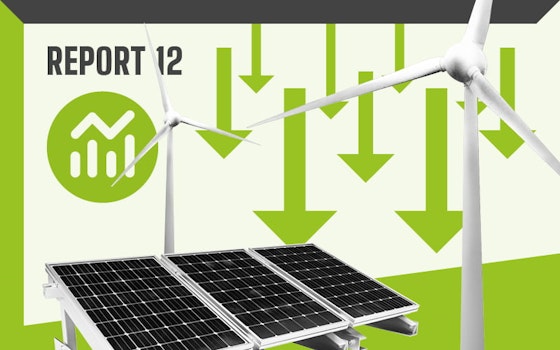
Breaking the Link: The Macroeconomic Case for Fixing Britain’s Energy Market
How lower electricity prices could boost growth, cut inflation and leave every Brit better off
Report releasedDecember 11, 2025
View ReportSee the full report on the Green Britain Foundation website
Historically, the UK’s focus on renewables has centred on large-scale solar farms and wind turbines. Yet in 2023, with energy prices high and the country seeking greater energy independence, interest in rooftop solar on individual homes has grown substantially. This study set out to fill a knowledge gap: exactly how many British homes can install rooftop solar, and how much power (and savings) that would generate if done at scale.
The impetus for the research came when the founder of Ecotricity, Dale Vince, was asked about total UK rooftop solar potential at a parliamentary hearing. Discovering that no comprehensive national data existed, Ecotricity commissioned a data-driven investigation, partnering with remote-sensing specialists to get precise measurements of rooftop suitability. The results show that the country could leverage a substantial share of its electricity needs from the sun, directly on people’s homes—an opportunity the report calls the “rooftop revolution.”
To achieve a statistically sound estimate of rooftop potential, researchers used an AI-based system provided by Absolar, a technology spin-out from the University of Southampton. This involved:
Sampling 10,000 buildings nationwide for their rooftop dimensions, orientation, and shading factors.
Remote Sensing and GIS (Geographic Information Systems) technology to extrapolate findings from the sample set to the wider national building stock.
Verification: Data was checked against real-world conditions, verifying solar simulations with actual cases to refine accuracy.
The team applied specific thresholds for sunlight availability (e.g., annual irradiance), orientation (south-facing being ideal, with east- and west-facing also considered “feasible”), and roof condition (size, slope, structural viability, shading). The process ensured that only those rooftops truly able to sustain cost-effective solar PV installations were counted as “feasible” or “suitable.”
System Size: The typical home-scale system is around 4–5 kW, though actual capacity depends on roof shape and space.
Solar Yields: The model includes average UK conditions, factoring in regional variation in sunshine hours and typical shading from trees, adjacent buildings, or chimneys.
Economic Calculations: Retail electricity values used for cost-savings estimates. Historical, current, and high-crisis prices are compared to highlight how variable energy costs can amplify the benefits of rooftop solar.
Majority of UK Homes are Solar-Compatible
Over 65% of all British dwellings have rooftops that meet the baseline technical requirements for solar installations. In more detail, 50% have ideal south-facing configurations, while an additional 17% have either east- or west-facing rooftops that can still produce enough power to be financially viable.
Potential Production
If these compatible homes were outfitted with photovoltaic (PV) panels, they would generate around 45 TWh of clean electricity each year—equivalent to the UK’s current onshore wind production. Put another way, this contribution could supply more than 13% of the nation’s entire electricity demand (domestic, commercial, and industrial combined), depending on year-to-year variations in demand and sunshine.
Significant Financial Payoff
At pre-energy-crisis electricity prices, the annual retail value of the rooftop solar “harvest” is an estimated £8 billion. Under the elevated prices seen in 2022–2023, that figure doubles to about £16 billion. At the peak of the crisis, it would have reached as high as £32 billion, underscoring how important rooftop solar could be as a hedge against volatile global markets.
Reduced System Losses
By producing electricity directly where it’s consumed, rooftop solar avoids distribution losses in the grid (estimated at around 5%). Under high electricity prices, those avoided losses alone can be worth half a billion pounds per year at scale.
Job Creation and Energy Independence
Installing panels on millions of rooftops would spur a boom in skilled and semi-skilled labour (electricians, roofers, surveyors, product installers, inspectors), creating thousands of new green jobs. Widespread adoption would also reduce reliance on fossil fuels and imports, shifting the power balance from large-scale energy companies toward ordinary households.
Bottlenecks and Grid Constraints
Whereas large solar farms and wind projects face grid connection queues of 10–15 years, the small-scale nature of rooftop PV typically fits into local distribution systems without requiring major upgrades. This shorter lead-time means the build-out can be much faster.
Despite the technology’s potential and falling costs, only 3.9% of UK homes currently have solar panels. The report identifies two major obstacles:
Historic Cuts to Support Schemes
In 2019, the UK Government ended its feed-in tariff (FiT) program without establishing an equivalent replacement, causing residential solar installations to plummet by over 90% in just one month.
Policy Indifference
While the UK Government introduced the Smart Export Guarantee (SEG), critics argue that rates are too low to incentivise swift rooftop adoption. Moreover, many property owners face bureaucratic hurdles, including ambiguous planning regulations and limited financial support.
Revived Incentives: An updated scheme—potentially a floor price for surplus solar electricity—could encourage investment, especially for low- to middle-income households.
Streamlined Planning: Simplifying regulations and removing red tape around rooftop solar would enable far more households to install panels quickly.
Financial Innovations: Green loans, zero-interest financing, or on-bill repayment schemes could broaden access to rooftop solar for those lacking the upfront capital.
The Rooftop Solar Report 2023 demonstrates that small-scale solar has the potential to be a game-changer in the UK’s energy landscape. Harnessing suitable rooftop space—on over 65% of British homes—would deliver large volumes of clean, locally produced electricity, worth billions annually while insulating households from volatile global energy markets. Such an initiative would accelerate decarbonisation, create tens of thousands of jobs, and give families greater control over their energy bills.
To unlock this potential, the report argues, political leaders must end years of neglect and put in place practical measures—restoring effective incentives, removing planning barriers, and expanding finance options. With demand for new energy solutions rising amid climate concerns and high energy prices, the opportunity to kickstart a “rooftop revolution” has never been more compelling. By combining proven technology with enabling policy, the UK can swiftly ramp up distributed solar power, making households central players in the push for energy independence and net zero ambitions.
How lower electricity prices could boost growth, cut inflation and leave every Brit better off
Report releasedDecember 11, 2025
View ReportA practical plan to bring prices down, tackle inequality and stabilise our economy
Report releasedOctober 27, 2025
View ReportA new plan to end Britain’s dependence on gas prices and bring down electricity costs
Report releasedOctober 27, 2025
View ReportBritain could’ve saved £50bn with North Sea CfDs. Lower bills, secure jobs, fair energy transition — no more chaos or windfalls for fossil giants. Time to fix the system.
Report releasedSeptember 11, 2025
View Report

